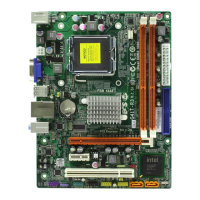
Do you have a question about the ECS G41T-R3 and is the answer not in the manual?
| Form Factor | Micro ATX |
|---|---|
| CPU Socket | LGA 775 |
| Memory Type | DDR3 |
| Memory Slots | 2 |
| Maximum Memory | 8 GB |
| Graphics | Integrated Intel GMA X4500 |
| Storage Interface | 4 x SATA 3Gb/s |
| IDE Ports | 1 x IDE |
| Video Outputs | 1 x VGA |
| Audio | Realtek ALC662 6-Channel HD Audio |
| Chipset | Intel G41 |
| Expansion Slots | 1 x PCIe x16, 1 x PCIe x1, 2 x PCI |
| USB Ports | 8 x USB 2.0 (4 on back panel, 4 via headers) |
Details copyright protection and usage restrictions for the publication.
States that information is subject to change without notice and disclaims implied warranties.
Acknowledges registered trademarks of Microsoft and Intel, and other product names.
Explains FCC rules compliance for Class B digital devices and interference guidelines.
Confirms compliance with FCC Part 15 rules, subject to specific operating conditions.
States compliance with Canadian Interference-causing Equipment Regulations.
Outlines the manual's content, listing chapters and their brief descriptions.
Welcomes the user and introduces the G41T-R3 motherboard for desktop markets.
Details features of the processor, chipset (G41 NB, ICH7 SB), and memory support.
Lists detailed specifications including CPU, Chipset, Memory, Expansion Slots, Storage, Audio, and BIOS.
Provides an illustrated guide to the physical components on the motherboard.
A labeled list of motherboard components and their corresponding labels.
Essential safety guidelines to follow before and during motherboard installation.
Guidance on selecting a compatible computer case based on motherboard specifications.
Instructions for physically mounting the motherboard within a computer case.
Explains how to set jumpers for correct motherboard configuration.
Detailed steps and precautions for installing the CPU onto the motherboard socket.
Procedure for installing DDR3 SDRAM modules into the motherboard slots.
Qualified Vendor List for DDR3 1333/1066 memory modules tested for this motherboard.
Information on PCI Express and PCI slots and how to install expansion cards.
Guides on connecting SATA, Front Panel Audio, USB, SPDIF, and Serial ports.
Instructions for connecting power supply, fan, speaker, and front panel connectors.
Overview of the BIOS Setup Utility and its capabilities for configuring system parameters.
Explains when to use the Setup Utility and the purpose of standard configuration.
Procedure for accessing the BIOS Setup Utility after powering on the system.
Steps to reset BIOS settings to factory defaults, often needed after CMOS clear.
Lists the keyboard keys used for navigating and interacting within the BIOS Setup Utility.
Details basic system information and settings for date, time, and IDE/SATA devices.
Covers advanced system configurations like thermal management and boot order.
Configuration for devices on the PCI bus and Plug and Play capabilities.
Monitors critical voltages, temperatures, and fan speeds for system health.
Advanced settings for memory frequency, timings, and onboard graphics memory.
Settings for onboard devices like IDE, SATA, Audio, LAN, USB, and Serial ports.
Configures system power saving features, suspend modes, and wake-up events.
Allows adjustment of CPU clock speed, system bus frequency, and voltages.
Procedure for installing or changing the supervisor password for system access.
Procedure for installing or changing the user password for system access.
Option to save current BIOS configuration changes and exit the utility.
Option to discard any changes made in the BIOS setup and exit.
Instructions on how to download and install updated BIOS versions from the manufacturer.
Describes the contents of the support disc, including drivers and utilities.
Explains the automated installation process for drivers and software on supported OS.
Introduces eJIFFY as a fast boot program for instant access to web browsing and chat.
Steps for installing eJIFFY utility and activating it through BIOS setup.
Describes how to select and enter the eJIFFY operating system from the post screen.
Illustrates and explains the main icons available in the eJIFFY menu interface.
Addresses common issues when the system does not power up or fans do not run.
Tips for diagnosing and resolving start-up issues that occur after extended use.
Provides essential PC care guidelines to prolong motherboard life and performance.
A visual guide to systematically diagnose and resolve common PC hardware issues.
